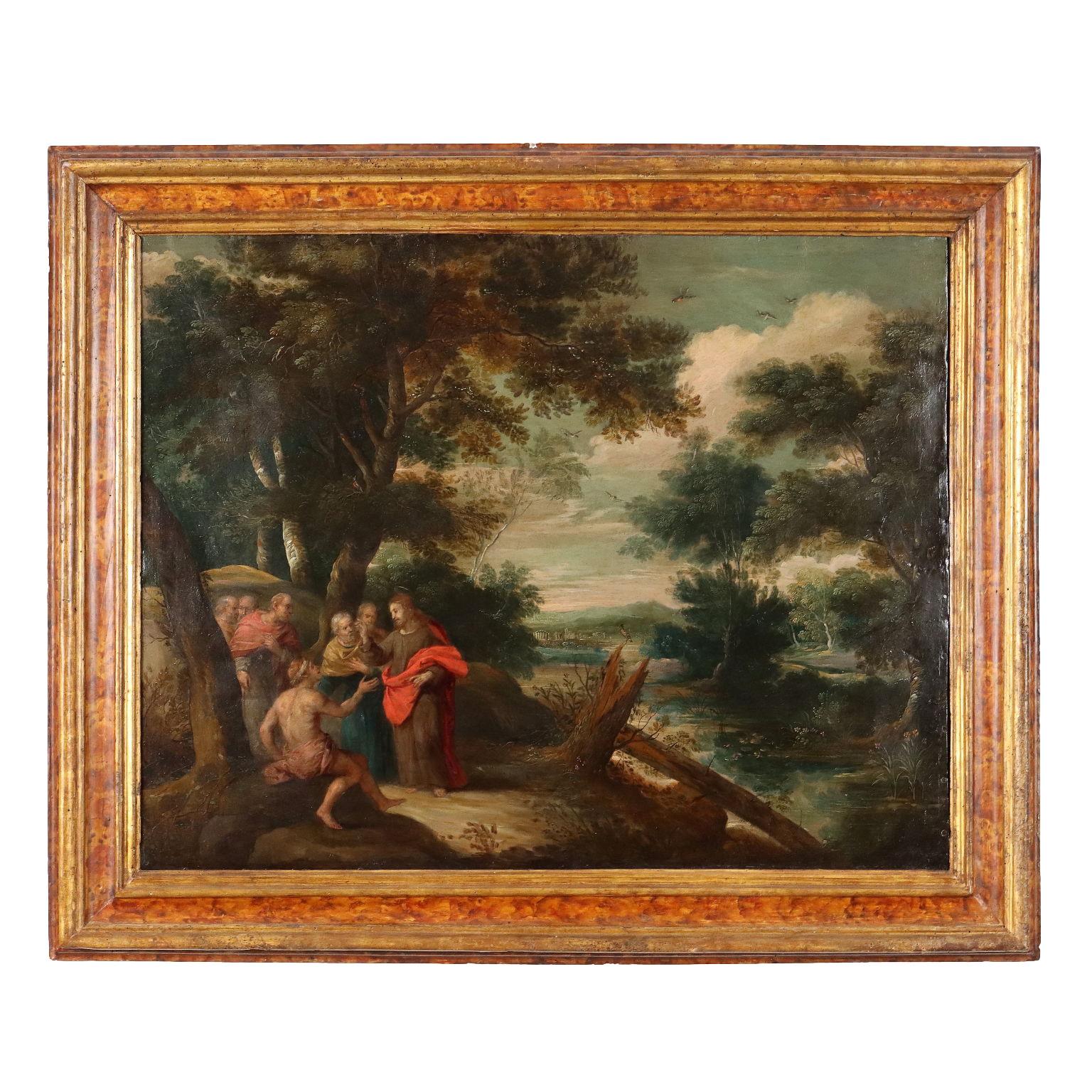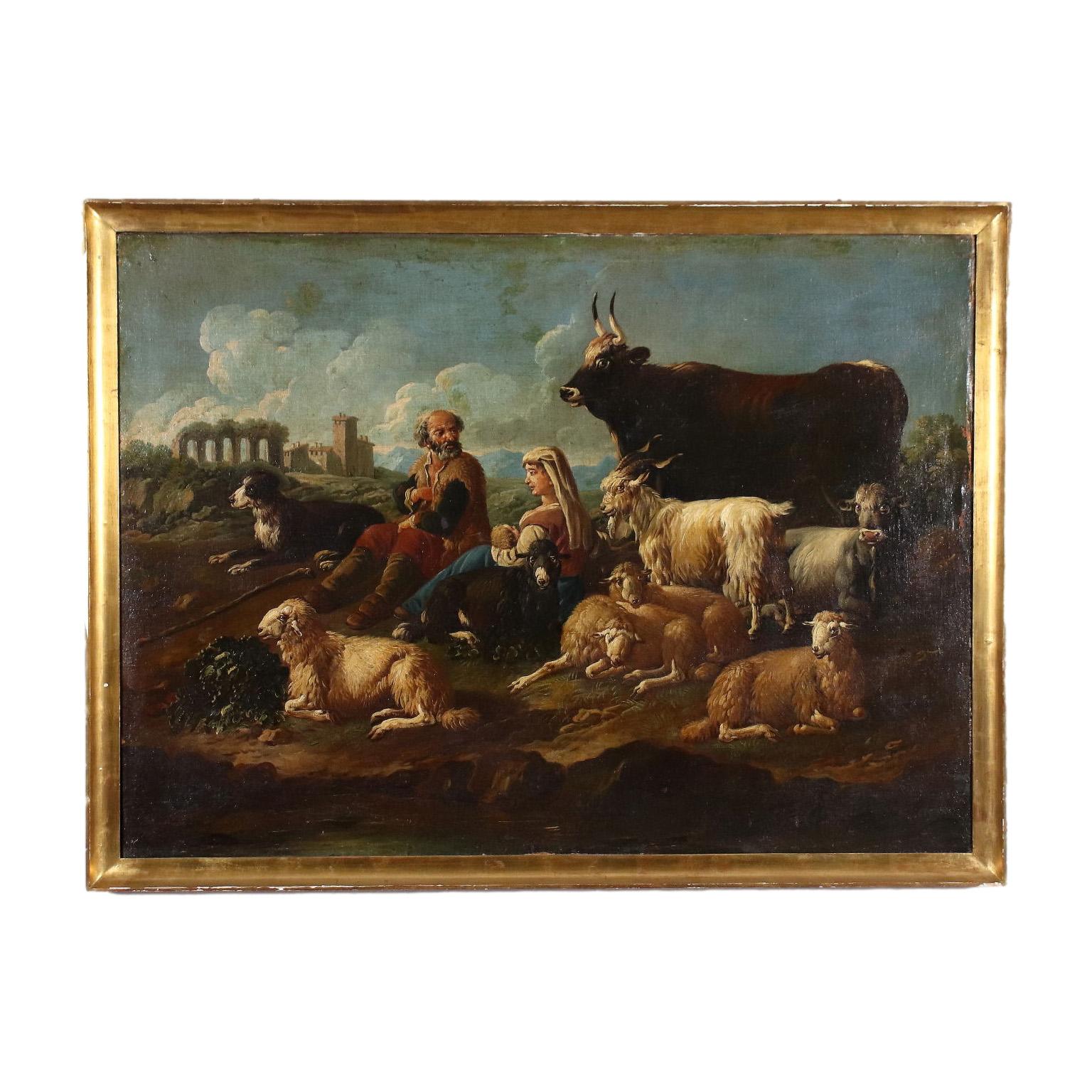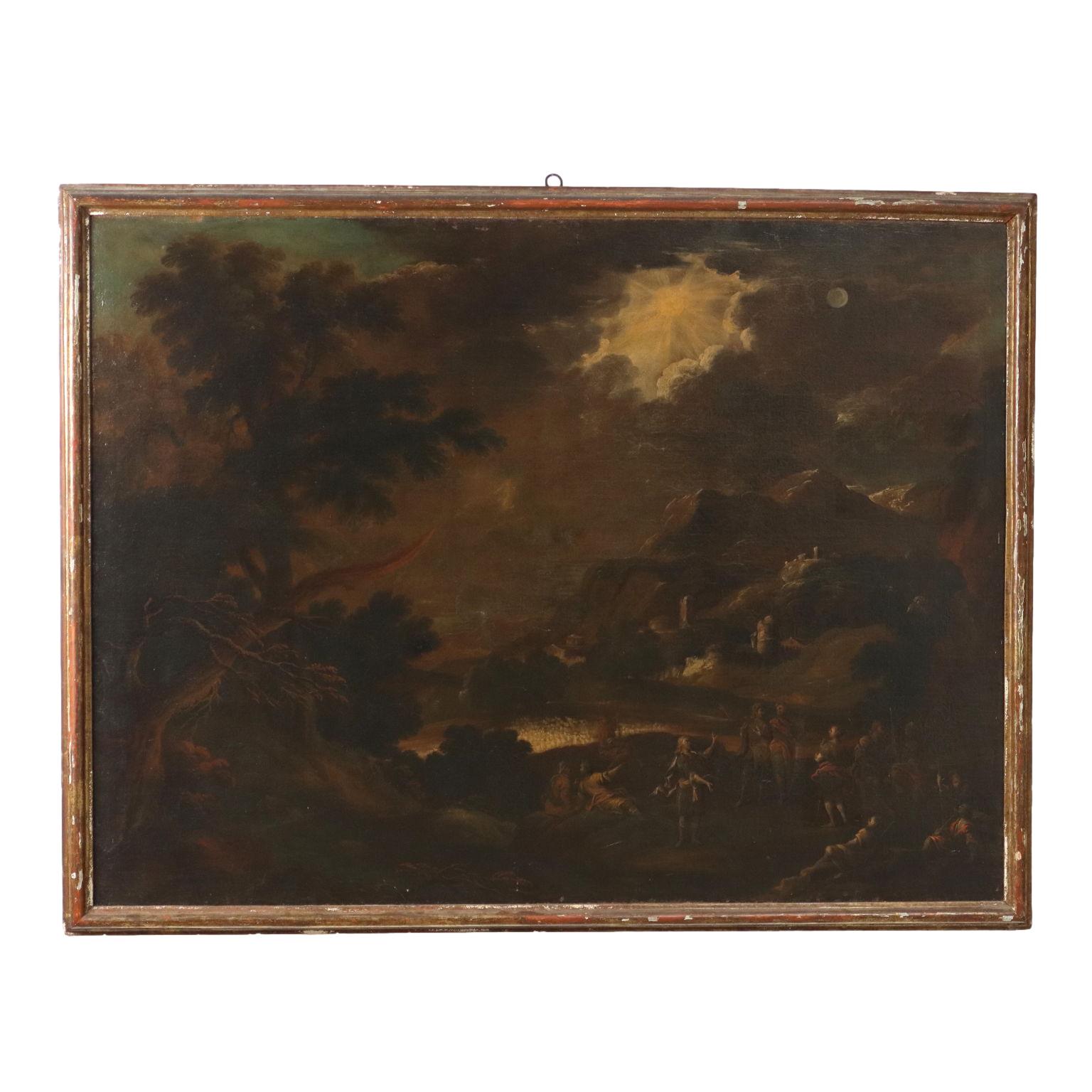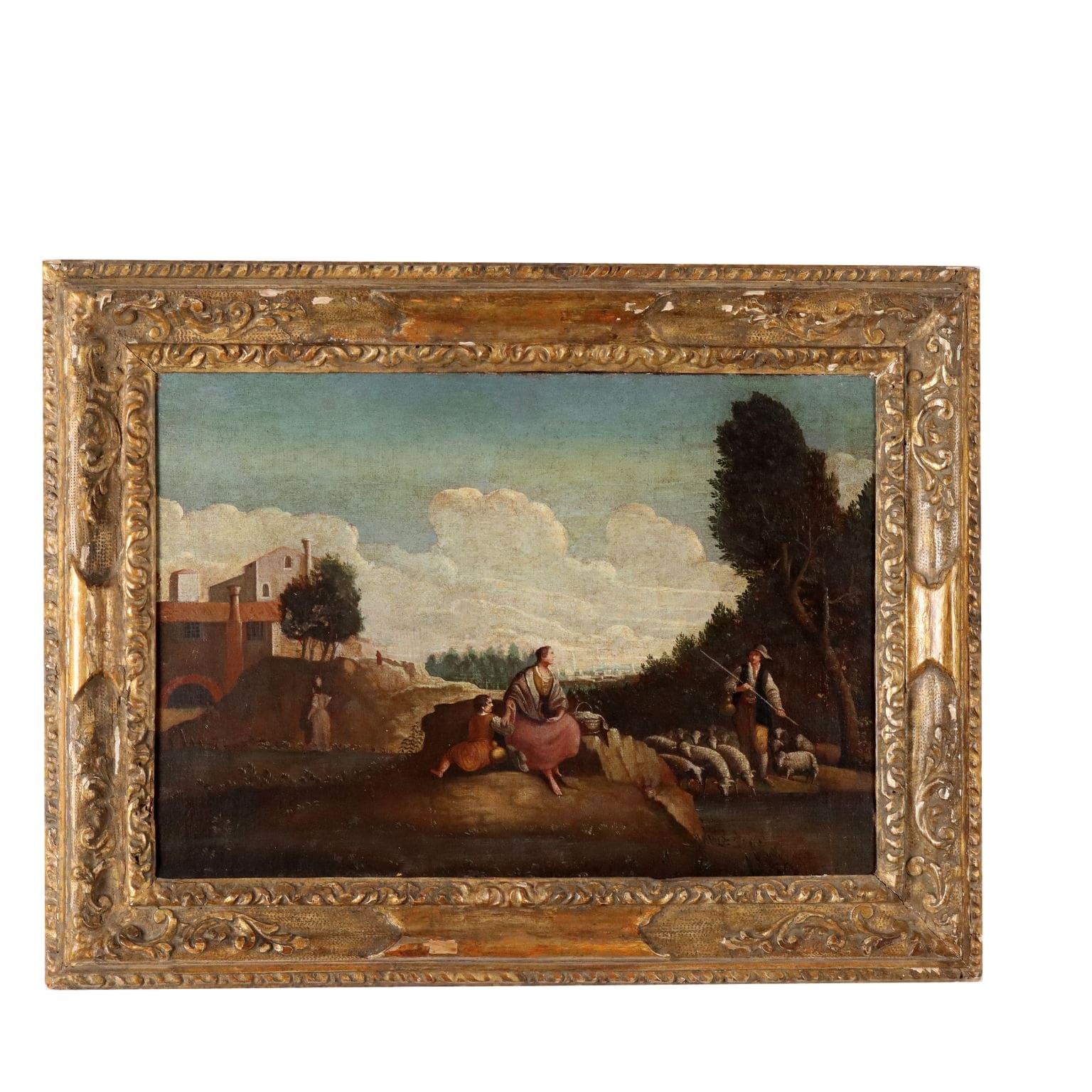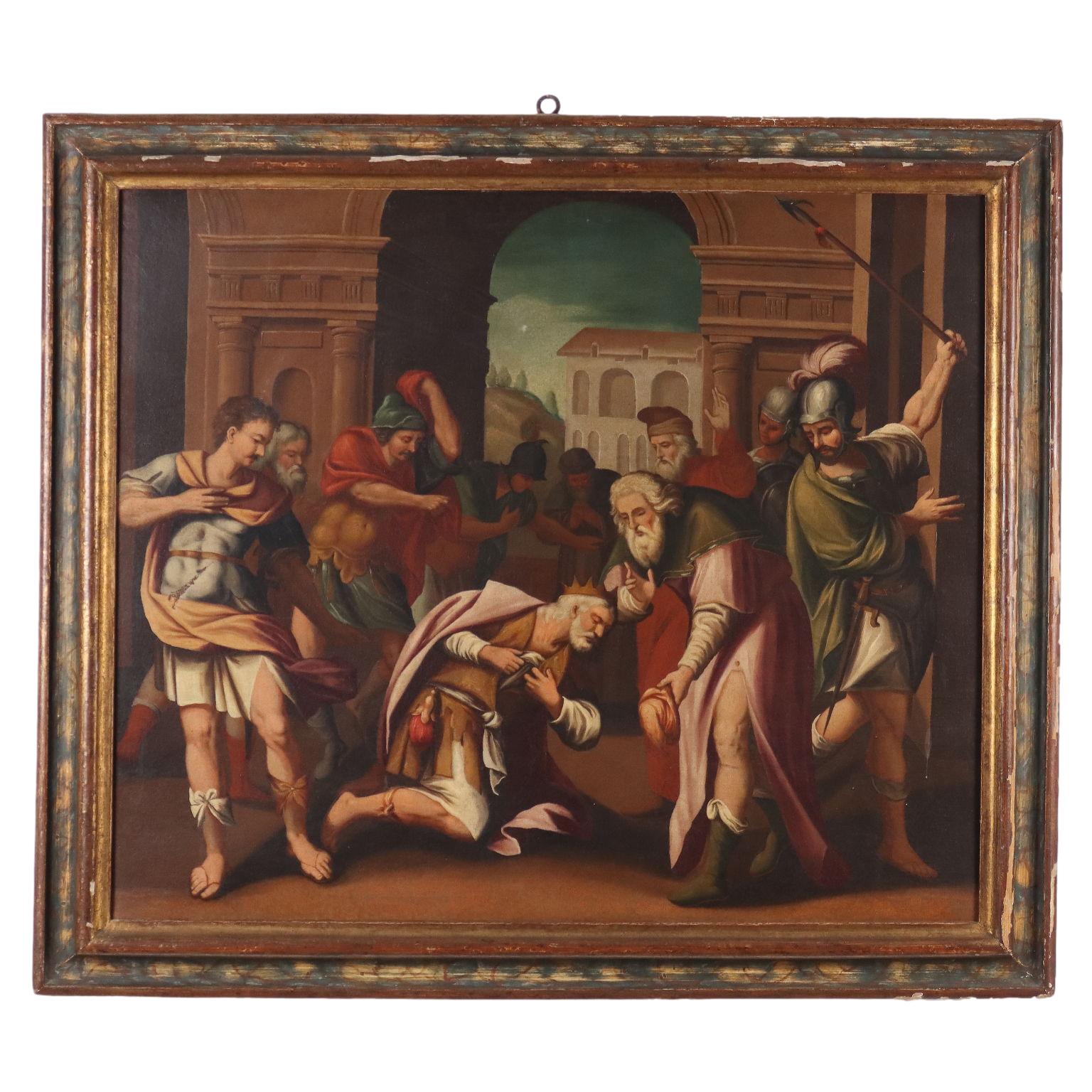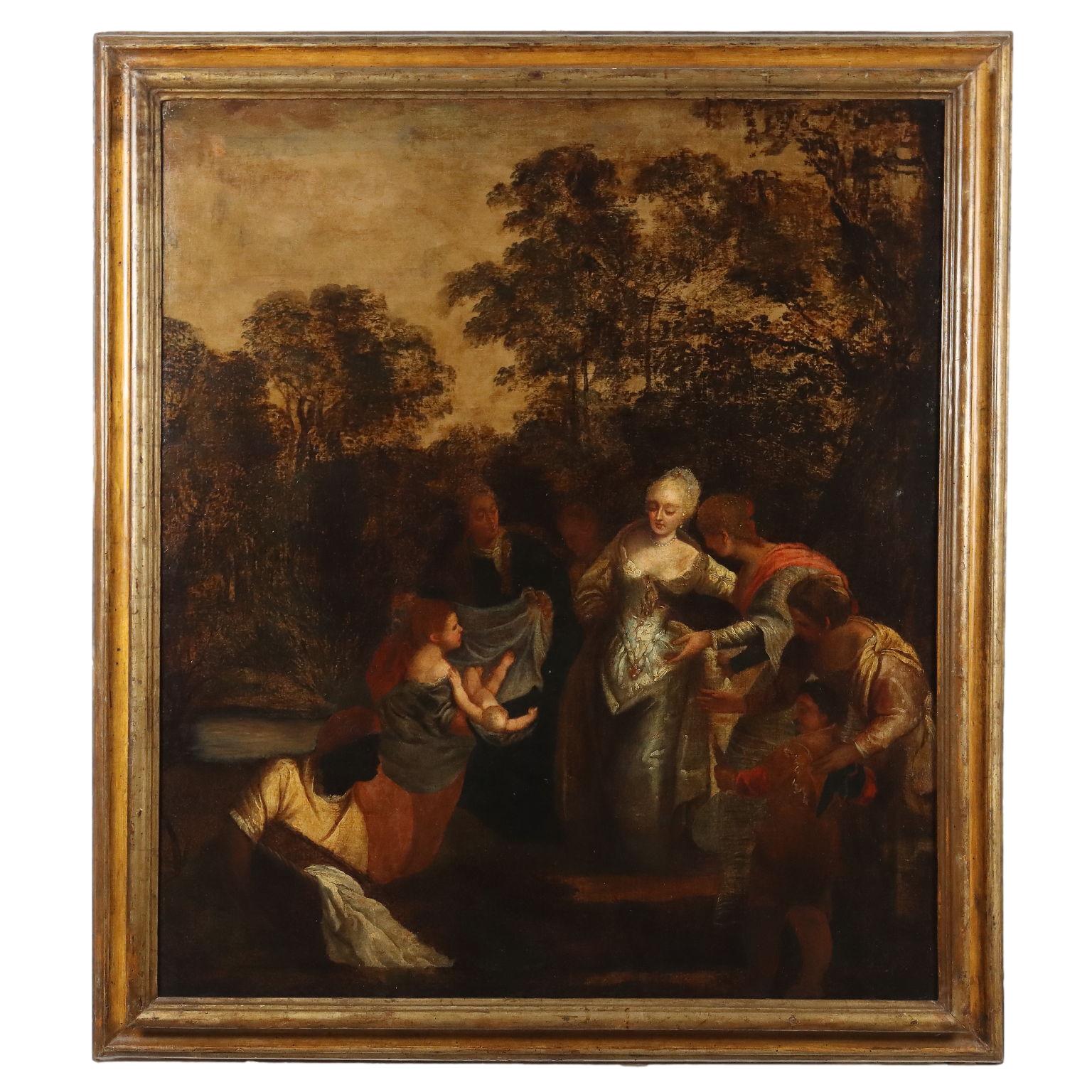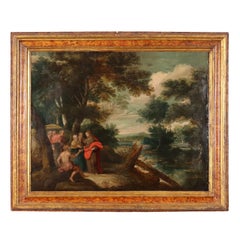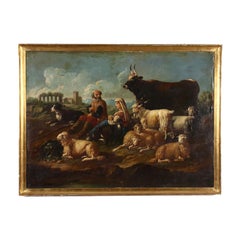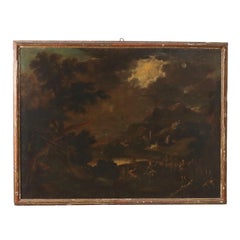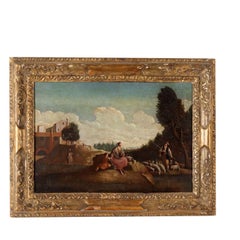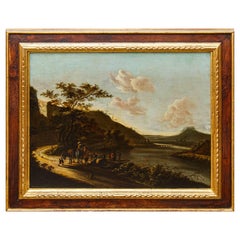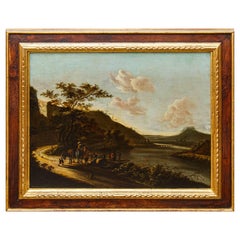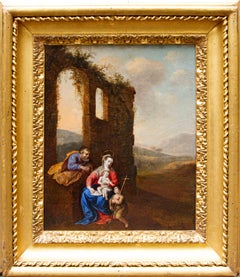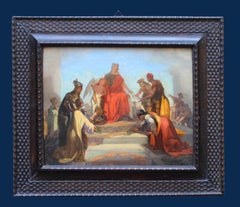Items Similar to Dipinto Scena di Vita Popolare XVIII secolo
Want more images or videos?
Request additional images or videos from the seller
1 of 15
UnknownDipinto Scena di Vita Popolare XVIII secoloXVIII secolo
XVIII secolo
$6,555.02
£4,799.58
€5,460
CA$8,900.74
A$9,977.66
CHF 5,203.12
MX$122,301.71
NOK 65,932.29
SEK 62,683.90
DKK 41,553.44
Shipping
Retrieving quote...The 1stDibs Promise:
Authenticity Guarantee,
Money-Back Guarantee,
24-Hour Cancellation
About the Item
Olio su tela. Scuola nord-europea del XVIII secolo.
Nei pressi di un piccolo aggregato di edifici, lungo la strada sterrata, si svolge una scena di vita popolare, animata da diverse figure: in primo piano a destra due cacciatori offrono le loro prede e della frutta ad una donna gravida, che viaggia a cavallo accompagnata dal compagno; in secondo piano, un paio di donne siedono per terra a riposare con i loro bambini, una delle due sta allattando; e ancora gruppi di persone che chiacchierano, mentre altri sono arrampicati sui mucchi di fieno coperti sotto il granaio.
Le figure spiccano per i colori vivaci dei loro abiti sullo sfondo quasi monocromatico di tinte di terra, con gli edifici che si confondono con il paesaggio piatto e brullo.
Il dipinto, ancora in prima tela, presenta segni di un piccolo strappo sul retro.
È presentato in cornice in stile.
- Creation Year:XVIII secolo
- Dimensions:Height: 39.77 in (101 cm)Width: 68.12 in (173 cm)Depth: 2.37 in (6 cm)
- Medium:
- Period:
- Condition:
- Gallery Location:Milan, IT
- Reference Number:1stDibs: LU680316568602
About the Seller
4.8
Gold Seller
Premium sellers maintaining a 4.3+ rating and 24-hour response times
Established in 2017
1stDibs seller since 2017
125 sales on 1stDibs
Typical response time: 6 hours
- ShippingRetrieving quote...Shipping from: Milan, Italy
- Return Policy
Authenticity Guarantee
In the unlikely event there’s an issue with an item’s authenticity, contact us within 1 year for a full refund. DetailsMoney-Back Guarantee
If your item is not as described, is damaged in transit, or does not arrive, contact us within 7 days for a full refund. Details24-Hour Cancellation
You have a 24-hour grace period in which to reconsider your purchase, with no questions asked.Vetted Professional Sellers
Our world-class sellers must adhere to strict standards for service and quality, maintaining the integrity of our listings.Price-Match Guarantee
If you find that a seller listed the same item for a lower price elsewhere, we’ll match it.Trusted Global Delivery
Our best-in-class carrier network provides specialized shipping options worldwide, including custom delivery.More From This Seller
View AllPainting with a Healing Scene 17th Century
Located in Milan, IT
Oil on copper. Flemish school of the seventeenth century.
The painting, attributed by oral tradition to Frans Francken the younger (1581 -1642), depicts a miraculous healing perform...
Category
17th Century Other Art Style Figurative Paintings
Materials
Oil
$7,587 Sale Price
20% Off
Painted Landscape with Shepherds and Herds 17th century
Located in Milan, IT
Oil on Canvas.
The large scene, set in a hilly countryside, with a village and ruins in the background on the left, is completely occupied by the compact group of the many living fi...
Category
17th Century Other Art Style Landscape Paintings
Materials
Oil
$4,033 Sale Price
20% Off
Painted Landscape with Scene of Preaching 18th century
Located in Milan, IT
Oil on Canvas. Venetian school of the 18th century.
The large northern landscape, with verdant mountain slopes in the midst of which a river flows, is inhabited by several figures in...
Category
18th Century Other Art Style Figurative Paintings
Materials
Oil
$4,321 Sale Price
20% Off
Landscape Painting with Pastoral Scene, 18th century
Located in Milan, IT
Oil on Canvas.
Of flavor bucolic and serene, the scene set in the countryside on the edge of the hamlet that can be glimpsed on the left shows a woman and her son standing near a st...
Category
18th Century Other Art Style Landscape Paintings
Materials
Oil
$1,498 Sale Price
20% Off
Dipinto Scena di Pentimento di un Re XVII-XVIII secolo
Located in Milan, IT
Olio su tela.
Al centro della scena un re si inginocchia in atteggiamento contrito davanti ad un uomo anziano, che si china verso di lui con atteggiamento di benevola accoglienza; al...
Category
Late 17th Century Other Art Style Figurative Paintings
Materials
Oil
$3,121 Sale Price
20% Off
Painting Moses Saved from the Waters 18th century
Located in Milan, IT
Oil on Canvas.
The painting looks to the similar work by Paolo Veronese (1528-1588), dated around 1560-70 and now in the Prado Museum, from which our painting takes up the compositio...
Category
18th Century Other Art Style Figurative Paintings
Materials
Oil
$5,263 Sale Price
20% Off
You May Also Like
XVII secolo, Paesaggio con personaggi
Located in Milan, IT
XVII secolo
Paesaggio con personaggi
Olio su tela, cm 72 x 92
Con cornice, cm 95 x 112
Category
Antique Late 17th Century Dutch Other Paintings
Materials
Canvas
XVII secolo, Paesaggio con personaggi
Located in Milan, IT
XVII secolo
Paesaggio con personaggi
Olio su tela, cm 72 x 92
Con cornice, cm 95 x 112
Category
Antique 18th Century and Earlier Dutch Other Paintings
Materials
Canvas
Circle of Bartholomeus Breenbergh, Holy Family
By Bartholomeus Breenbergh
Located in Milan, IT
Workshop of Bartholomeus Breenbergh (Deventer, 1598 - Amsterdam, 1657)
Holy Family with San Giovannino
Oil on African marble, 30 x 24 cm
Framed, 45 x 38 cm
The strong emotional i...
Category
17th Century Other Art Style Figurative Paintings
Materials
Marble
Attributed to Hannibal Gatti, Allegorical Scene
By Annibale Gatti
Located in Milan, IT
Annibale Gatti (Forlì 1827 - Florence 1909), attr.
Allegorical Scene
Oil on paper applied to board, 25 x 30 cm - with frame 36 x 42
The allegorical work, by analysis and stylistic...
Category
19th Century Other Art Style Figurative Paintings
Materials
Paper, Oil
Circle of Francesco Battaglioli, Architecture with Swans
By Francesco Battaglioli
Located in Milan, IT
Workshop of Francesco Battaglioli (Modena, c. 1710 - Venice, after 1796)
Baroque palace architecture with elegant staff and swans
Oil on canvas...
Category
18th Century Other Art Style Landscape Paintings
Materials
Canvas, Oil
17th Century, Italian Painting by Pier Francesco Cittadini, Jacob and his Family
Located in IT
Pier Francesco Cittadini (Milan, 1616-Bologna, 1681)
"Jacob and his family go to Egypt"
Oil on canvas, cm 109 x 190 (canvas only)
The valuable painting, made in oil on canvas, depicts Jacob and his family go to Egypt and we believe it can be, given the high quality painting, autograph work of Italian Pier Francesco Cittadini (Italy Milan, 1616 - Bologna, 1681) made after 1647. The work, in excellent condition is accompanied by a coeval frame in wood finely carved and golden.
The scene depicted, which was confused with the Flight to Egypt in the past years, is instead identified with the biblical episode of Jacob’s journey. In the foreground, reading the painting from left to right, we see a caravan composed of animals, including donkeys, dromedaries, goats, dogs and horses and people, women, men and slaves, who carry on their journey along the banks of a river, following a path that to the right, would seem to lead to the through of a bridge. In addition to the watercourse is described an environment characterized by large rocks and impervious come far to cover the entire verticality of the canvas. On the left, in the distance, we see the tail of the caravan that runs along the steep path. Large trees enliven and harmonize the environment, as well as white and grey clouds characterize the predominantly clear sky and illuminated on the right by sunlight.
The story is told in the Bible, Book of Genesis, 30, 25, passage in which is described the flight of Jacob from Haran after the contrasts with Laban, father of his wife Rachel. Jacob is the third great patriarch of the Bible. From his descendants originate the twelve generations of the people of Israel. He is the son of Isaac and Rebekah, who led him to flee from the wrath of Esau to Haran to seek refuge from his brother, Laban. At his uncle’s house Jacob met his daughter Rachel. As soon as he saw his cousin, Jacob was taken. Jacob will stay seven years in the service of Laban to marry his beloved Rachel. But Laban, with a deception, will give him in marriage first Lia, the least beautiful eldest daughter, and only after another seven years the splendid Rachel. From his first wife he will have several children, while Rachel will give birth to the beloved son, Joseph, who will become viceroy of Egypt.
After years of service, Jacob asked to be paid with every dark-coloured garment among the sheep and every spotted and dotted garment among the goats. Laban accepted and sent away from his sons all the leaders of that kind. So Jacob took fresh branches of poplar, almond and plane tree, and flayed them, and put them in the troughs. The optical suggestion induced the goats and the sheep to conceive and give birth to dark, striped and dotted garments. He also ensured that all the strongest and healthiest leaders of the flock of Laban would drink near the barked branches, thus assuring a genetic superiority to his part of the flock. His flocks grew numerous and strong and he became richer than his relative, arousing envy. It was clear that Laban would not respect him much longer. At the suggestion of the Lord, Jacob decided to return to Canaan. Trying to avoid any possible dispute, he left with his family while Laban was absent for shearing sheep. But when, three days later, his uncle returned home, he became angry, feeling offended because Jacob had gone secretly and had not allowed him to greet his daughters and grandchildren. In addition, his teraphim, statuettes, or idols, which depicted the family deities, had disappeared. After 7 days of pursuit, Laban and his men reached Jacob’s group on Mount Gilead, in the mountainous region west of the Euphrates River, where his uncle and grandson had a stormy conversation. The younger man was outraged at being accused of stealing idols and told Labano to rummage through his family’s tents at will. Neither of them could know or even imagine that it was Rachel who took the idols and hid them in the saddle of the camel. During the search, she sat down firmly on the saddle, apologizing for not being able to get up, «because I usually have what happens to women» (Gen 31:35). So the loot wasn’t discovered.
The author of this work was inspired by the composition of an engraving by Stefano Della Bella (1610-1664) of circa 1647. The engraving by Stefano della Bella bears the title "Iacob sur ses vieux jours quitte sans fascherie pour voir son filz Ioseph, sa terre et sa patrie" and is signed on the bottom left "Stef. of the Beautiful In. et fe." while on the right it is declared "Cum privil. Regis", that is with license of the king.
Stefano Della Bella (Italy - Florence, May 18, 1610-Florence, July 12, 1664) was born in a family of painters, sculptors and goldsmiths and was left early orphan of his father sculptor, he dedicated himself first to the art of goldsmith at the school of Giovanni Benedetto Castiglione and Gasparo Mola, then turning his attention to drawing and engraving. He soon began drawing figures and copying the etchings of Jacques Callot, which inspired his early works. Under the protection of the Medici, in particular of Don Lorenzo, cadet son of Grand Duke Ferdinand I, Della Bella has the opportunity to make study trips to Rome, where he stayed from 1633-1636; In Rome he met French engravers and publishers of prints such as Israël Henriet and François Langlois, who influenced his decision to move to Paris in 1639, four years after the death of Callot. In Paris he soon reached, thanks to the engravings commissioned by Cardinal Richelieu, the success also worldly; he frequented courtiers, theatre artists and writers, while refusing too oppressive honors. In 1646-1647 he continued his travels in the Netherlands to Amsterdam, Antwerp and Dordrecht. He returned to Florence in 1650 and resumed working under the protection of the Medici court, working for his patrons. In 1656 he became a member of the Academy of Apatists.
The painting object of this study is reasonably attributable to Pier Francesco Cittadini, or Pierfrancesco Cittadini, called the Milanese or the Franceschino (Italy - Milan, 1616-Bologna, 1681) as some exemplary stylistic comparisons proposed to follow can prove.
Pier Francesco Cittadini was an Italian baroque painter, mainly active in Bologna.
His artistic training first took place with the painter Daniele Crespi...
Category
Antique Mid-17th Century European Baroque Paintings
Materials
Canvas, Giltwood
